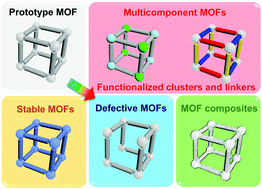From fundamentals to applications: a toolbox for robust and multifunctional MOF materials
Abstract
In recent years, metal–organic frameworks (MOFs) have been regarded as one of the most important classes of materials. The combination of various metal clusters and ligands, arranged in a vast array of geometries has led to an ever-expanding MOF family. Each year, new and novel MOF structures are discovered. The structural diversity present in MOFs has significantly expanded the application of these new materials. MOFs show great potential for a variety of applications, including but not limited to: gas storage and separation, catalysis, biomedicine delivery, and chemical sensing. This review intends to offer a short summary of some of the most important topics and recent development in MOFs. The scope of this review shall cover the fundamental aspects concerning the design and synthesis of MOFs and range to the practical applications regarding their stability and derivative structures. Emerging trends of MOF development will also be discussed. These trends shall include multicomponent MOFs, defect development in MOFs, and MOF composites. The ever important structure–property–application relationship for MOFs will also be investigated. Overall, this review provides insight into both existing structures and emerging aspects of MOFs.



 Please wait while we load your content...
Please wait while we load your content...